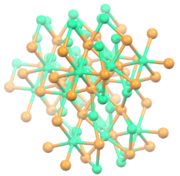
Back فوسفيد الكالسيوم Arabic فوسفید کلسیوم AZB Fosfur de calci Catalan Calciumphosphid German فسفید کلسیم Persian Kalsiumfosfidi Finnish Phosphure de calcium French 二リン化三カルシウム Japanese കാൽസ്യം ഫോസ്ഫൈഡ് Malayalam Calciumfosfide Dutch

| |
| Names | |
|---|---|
| IUPAC name
Calcium phosphide
| |
| Other names
Photophor, CP, Polythanol
| |
| Identifiers | |
3D model (JSmol)
|
|
| ChemSpider | |
| ECHA InfoCard | 100.013.766 |
| EC Number |
|
PubChem CID
|
|
| UNII | |
CompTox Dashboard (EPA)
|
|
| |
| |
| Properties | |
| Ca3P2 | |
| Molar mass | 182.18 g/mol |
| Appearance | red-brown crystalline powder or grey lumps |
| Density | 2.51 g/cm3 |
| Melting point | ~1600 °C |
| decomposes | |
| Hazards | |
| Occupational safety and health (OHS/OSH): | |
Main hazards
|
Source of toxic phosphine, dangerous reaction with water |
| GHS labelling: | |
   
| |
| Danger | |
| H260, H300, H311, H318, H330, H400 | |
| P231+P232, P233, P280, P301+P310, P405, P501 | |
| NFPA 704 (fire diamond) | |
Except where otherwise noted, data are given for materials in their standard state (at 25 °C [77 °F], 100 kPa).
| |
Calcium phosphide (CP) is the inorganic compound with the formula Ca3P2. It is one of several phosphides of calcium, being described as the salt-like material composed of Ca2+ and P3−. Other, more exotic calcium phosphides have the formula CaP / Ca2P2, CaP3, and Ca5P8.
Ca3P2 has the appearance of red-brown crystalline powder or grey lumps. Its trade name is Photophor for the incendiary use or Polytanol for the use as rodenticide.[citation needed]
